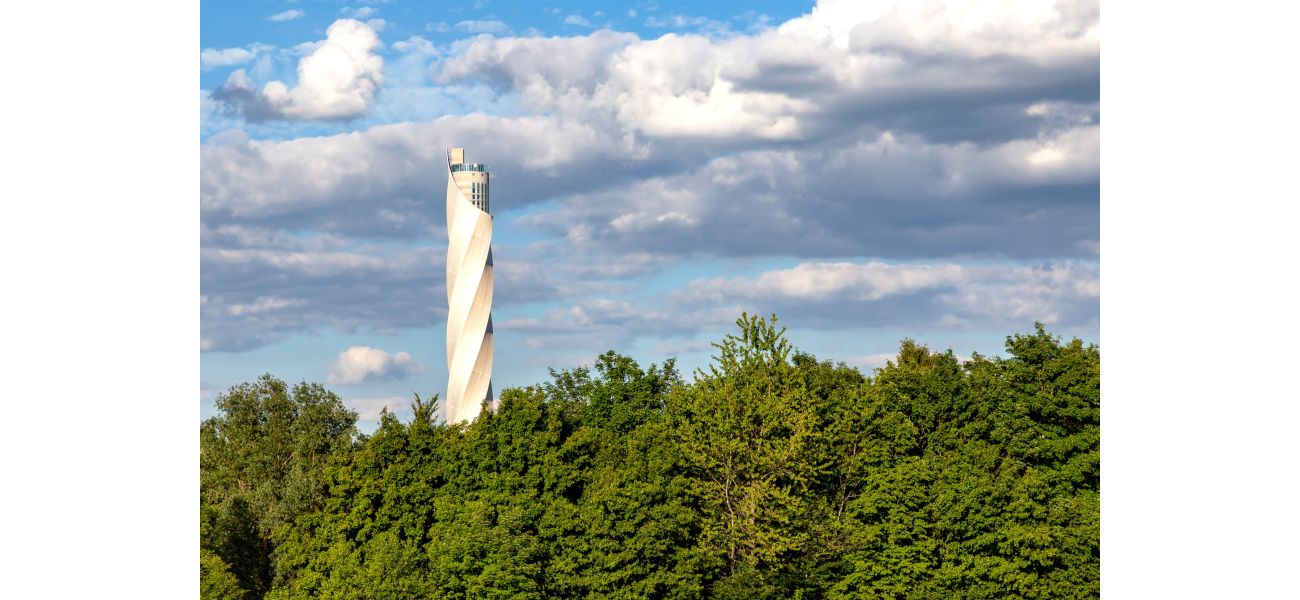Curiosity surrounds the construction of a 807ft tall building in the heart of a forest.
It's almost as tall as the Shard in London.
November 15th 2024.

It's hard to believe, but nestled in the heart of a lush forest in southwest Germany stands a towering skyscraper that rivals the height of London's iconic Shard. This massive structure, with its futuristic design and twisting shape, seems like something straight out of a science fiction movie. However, it's not a luxury apartment building, as one might expect. Instead, it serves a much more practical purpose - as a testing ground for elevators.
The TK Elevator Testturm, as it's officially known, is a remarkable 807 feet tall and has 12 separate shafts designed specifically for testing different types of elevator systems. This makes it the tallest elevator test tower in all of Germany, surpassing even the famous Shard. In fact, the only buildings in Germany that are taller than the TK tower are located in Frankfurt, which happens to be home to every one of Germany's top ten tallest buildings, with the exception of the TK Testturm.
Built in 2017 by the renowned engineering firm TK Elevator, this unconventional tower has become a hub for innovation and design in the elevator industry. Its state-of-the-art facilities are used to test the latest elevator technology, including high-speed models and groundbreaking Multi systems that can move both vertically and horizontally. These advancements could potentially revolutionize the way we think about elevators and reduce waiting times in tall buildings.
While the test tower may seem out of place in the quaint surroundings near the medieval town of Rottweil, it has quickly become a beloved part of the community and a popular tourist attraction. Visitors can even enter parts of the facility and enjoy a breathtaking view of the Black Forest and the Swiss Alps from the viewing platform at 761 feet. It's not just tourists who are drawn to this impressive structure, though. Engineers and architects from all over the world come to the TK Testturm to test out their latest technology and collaborate on future lift designs.
One of the most exciting innovations being tested at the TK Testturm is the Multi system, which uses magnetic levitation instead of traditional cables to move in multiple directions. This could potentially open up new possibilities for building design and reduce the limitations of traditional elevators. The tower's unique twisted design also serves a practical purpose, helping to reduce vibrations caused by wind and making it more stable.
When plans for the TK Testturm were first announced, there were skeptics who questioned the idea of building a modern tower in the middle of a picturesque forest. However, the tower has since become a beloved part of the local landscape and has even formed partnerships with schools and engineering programs. It's a testament to the tower's success and the positive impact it has had on the community.
In other news from the world of skyscrapers, designers have recently unveiled plans for what could be the longest building in the world, located in New York City. Dubbed "Big Bend," this massive structure would stretch over 4000 feet and curve in a giant upside-down U shape, pushing the limits of what we thought was possible in building design. Meanwhile, in Dubai, plans have been announced for a new skyscraper that would surpass even the Shard in height.
The Muraba Veil apartment block, as it's called, would be a staggering 70 feet taller than the Shard, standing at a height of 380 meters and a width of just 22.5 meters - making it the slimmest skyscraper in the world. With so many ambitious projects in the works, it's clear that the world of skyscrapers is constantly evolving and pushing the boundaries of what we thought was possible. We can't wait to see what's next.
The TK Elevator Testturm, as it's officially known, is a remarkable 807 feet tall and has 12 separate shafts designed specifically for testing different types of elevator systems. This makes it the tallest elevator test tower in all of Germany, surpassing even the famous Shard. In fact, the only buildings in Germany that are taller than the TK tower are located in Frankfurt, which happens to be home to every one of Germany's top ten tallest buildings, with the exception of the TK Testturm.
Built in 2017 by the renowned engineering firm TK Elevator, this unconventional tower has become a hub for innovation and design in the elevator industry. Its state-of-the-art facilities are used to test the latest elevator technology, including high-speed models and groundbreaking Multi systems that can move both vertically and horizontally. These advancements could potentially revolutionize the way we think about elevators and reduce waiting times in tall buildings.
While the test tower may seem out of place in the quaint surroundings near the medieval town of Rottweil, it has quickly become a beloved part of the community and a popular tourist attraction. Visitors can even enter parts of the facility and enjoy a breathtaking view of the Black Forest and the Swiss Alps from the viewing platform at 761 feet. It's not just tourists who are drawn to this impressive structure, though. Engineers and architects from all over the world come to the TK Testturm to test out their latest technology and collaborate on future lift designs.
One of the most exciting innovations being tested at the TK Testturm is the Multi system, which uses magnetic levitation instead of traditional cables to move in multiple directions. This could potentially open up new possibilities for building design and reduce the limitations of traditional elevators. The tower's unique twisted design also serves a practical purpose, helping to reduce vibrations caused by wind and making it more stable.
When plans for the TK Testturm were first announced, there were skeptics who questioned the idea of building a modern tower in the middle of a picturesque forest. However, the tower has since become a beloved part of the local landscape and has even formed partnerships with schools and engineering programs. It's a testament to the tower's success and the positive impact it has had on the community.
In other news from the world of skyscrapers, designers have recently unveiled plans for what could be the longest building in the world, located in New York City. Dubbed "Big Bend," this massive structure would stretch over 4000 feet and curve in a giant upside-down U shape, pushing the limits of what we thought was possible in building design. Meanwhile, in Dubai, plans have been announced for a new skyscraper that would surpass even the Shard in height.
The Muraba Veil apartment block, as it's called, would be a staggering 70 feet taller than the Shard, standing at a height of 380 meters and a width of just 22.5 meters - making it the slimmest skyscraper in the world. With so many ambitious projects in the works, it's clear that the world of skyscrapers is constantly evolving and pushing the boundaries of what we thought was possible. We can't wait to see what's next.
[This article has been trending online recently and has been generated with AI. Your feed is customized.]
[Generative AI is experimental.]
0
0
Submit Comment





